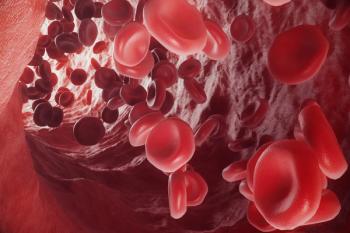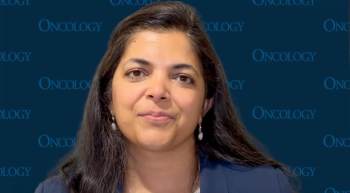
Four-drug regimen ups response, progression-free survival in older multiple myeloma patients
NEW ORLEANS-More is better, at least when it comes to treatments for multiple myeloma. Separate studies from a Spanish group and an Italian group showed that up-front use of four drugs improves durable responses and progression-free survival in elderly patients. Both studies also showed that a kinder, gentler weekly schedule of bortezomib (Velcade) instead of the standard twice-weekly schedule maintains efficacy and reduces toxicity.
NEW ORLEANS-More is better, at least when it comes to treatments for multiple myeloma. Separate studies from a Spanish group and an Italian group showed that up-front use of four drugs improves durable responses and progression-free survival in elderly patients. Both studies also showed that a kinder, gentler weekly schedule of bortezomib (Velcade) instead of the standard twice-weekly schedule maintains efficacy and reduces toxicity.
Yes to weekly bortezomib
Using melphalan instead of thalidomide as part of a modified-intensity three-drug combination with bortezomib/prednisone reduces toxicity without compromising efficacy in elderly patients (n=260) with multiple myeloma, according to results of a prospective, multicenter, randomized phase III trial. In this study, the modified-intensity regimens were bolstered by maintenance therapy.
Although melphalan causes more neutropenia, the cardiac toxicity seen with thalidomide is more difficult to manage, said lead author Maria-Victoria Mateos, MD, PhD, from Hospital Universitario de Salamanca in Spain. On the other hand, neutropenia can be managed with growth factor support.
No grade 3 cardiac events occurred in the melphalan arm, while 8.5% of those in the thalidomide induction arm had grade 3 cardiac events (five cardiac failure, two atrial fibrillation, two hypotension, one heart attack, one atrioventricular block).
Six cycles of both modified induction regimens-bortezomib/melphalan/prednisone (VMP) and bortezomib/thalidomide/prednisone (VTP)-were equally effective at a median follow up of 22 months for time to progression and progression-free survival. Overall survival as also similar: 81% for VMP vs 84% for VTP. Outcomes were the same in high-, intermediate-, and low-risk groups (
An important aspect of this study was the use of weekly bortezomib for induction therapy for cycles 2 through 6, instead of the standard twice-weekly schedule. “This study showed that the answer is ‘yes’ to weekly bortezomib,” Dr. Mateos said.
Patients (n=178) were randomized to maintenance therapy with bortezomib/thalidomide or bortezomib/prednisone for up to three years. Overall, maintenance therapy increased the complete response rate from 25% to 42%, but there were no significant differences between the two groups. Maintenance therapy reduced toxicities, especially peripheral neuropathy, she said.
A prospective, randomized, phase III Italian study in a similar population of elderly patients with newly diagnosed multiple myeloma (n=511) showed that induction therapy with a four-drug combination of bortezomib, melphalan, prednisone, and thalidomide (VMPT) followed by maintenance therapy with bortezomib and thalidomide (VT) achieved results comparable to those of the Spanish study (
“Both studies used four drugs. In our study, we used them up front and in the Spanish study, a three-drug combination was followed by a fourth drug for maintenance therapy,” explained lead author Antonio Palumbo, MD, University of Torino, A.O.U. San Giovanni Battista, Torino, Italy. This study showed that VMPT with VT maintenance was superior to VMP alone.
New treatments for VTE
Separate studies showed promising results for two different oral direct thrombin inhibitors for treatment of acute venous thromboembolism (VTE) and prevention of recurrent VTE, respectively. Both drugs are poised to replace warfarin, which has been the bane of existence for physicians and patients for many years because of its need for frequent monitoring and dose adjustments, dietary restrictions, drug interactions, and unpredictability. Both new drugs appear to overcome these problems. This is welcome news, since cancer patients are at high risk for developing VTE and VTE is a leading cause of death in this population.
Dabigatran vs warfarin in VTE
Dabigatran was as effective as warfarin for treating acute VTE, with a significant reduction in major or clinically relevant bleeding in the phase III RE-COVER trial (
“We are excited by these findings and feel they will change the standard of care for VTE, which affects a large number of our patients. Dabigatran is a potential replacement for warfarin,” explained Sam Schulman, MD, professor at McMaster University in Hamilton, Ontario.
The study randomized 2,539 patients 1:1 to six months of treatment with fixed-dose dabigatran 150 mg bid or warfarin (international normalized ratio, 2.0-3.0). The mean age of the patient population was 55 years. About 69% had deep venous thrombosis (DVT) as the index event, about 22% had pulmonary embolism (PE) only, and about 10% had both DVT and PE. One-quarter of patients had a history of previous VTE (
The cumulative risk of recurrent or fatal VTE after six months of treatment was similar for both groups. Dabigatran reduced the risk of a first major bleeding event and any bleeding event by 29% compared with warfarin (P = .0002). Major or clinically relevant bleeds were reduced by 37% in the dabigatran group (5.6% vs 8.8%, respectively; P = .002).
Rivaroxaban in long-term prevention of VTE
The phase III EINSTEIN-Extention (EXT) study showed that patients who received acute anticoagulation therapy for acute VTE could be safely and effectively treated with rivaroxaban (BAY 59-7939) for six to 12 months to prevent recurrences. Those who received six to 12 additional months of rivaroxaban had an 82% reduced risk of recurrent VTE, with a number needed-to-treat (NNT) of 15 patients to prevent one recurrent VTE.
The new direct thrombin inhibitor also incurred a low incidence of major bleeding of 0.7%, with the number of patients NNT to prevent harm of 139. The efficacy and safety of rivaroxaban were consistent irrespective of body weight and creatinine clearance, explained lead author Harry R. Bller, MD, from the Academic Medical Center in Amsterdam.
The randomized, double-blind, placebo-controlled study enrolled 1,197 patients treated for six to 12 months for VTE (53% had been enrolled in the EINSTEIN-Extention (EXT) study), said coauthor Dr. Mateos. Patients were randomized to treatment with a 20-mg oral daily dose of rivaroxaban or placebo for another six to 12 months (
Dr. Bller cautioned that these results in the setting of VTE should not be extrapolated to other settings without large randomized trials. He also said this study did not answer the question of how long to treat.
Newsletter
Stay up to date on recent advances in the multidisciplinary approach to cancer.

















































































